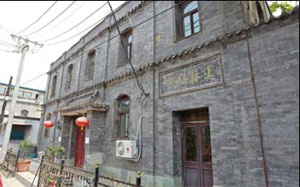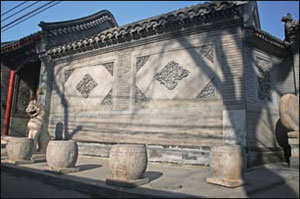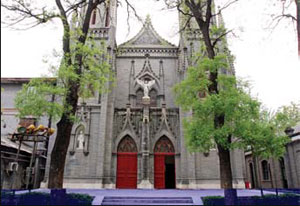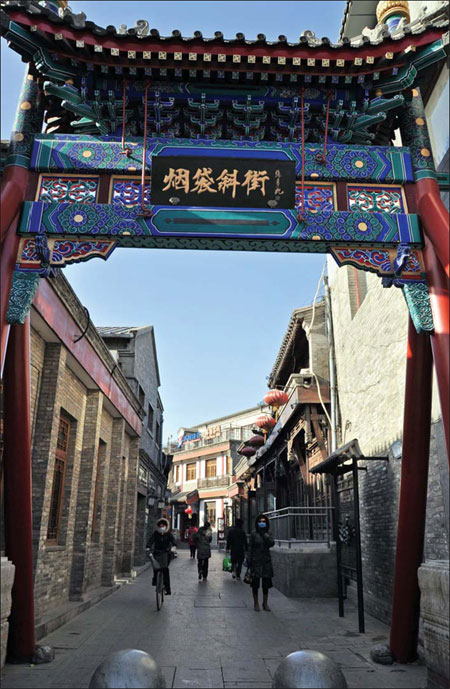Always the alleys
Updated: 2012-10-19 10:41
(China Daily)
|
|||||||||||
|
Tobacco Pipe Lane is one of the oldest commercial streets in Beijing. Photos Provided to China Daily |
Take a stroll through Beijing's Hutong to get a taste of history
Gleaming glass towers, rev-roaring cars stuck on ring roads, grandiose shopping malls and people rushing to and fro - such is the image of China's capital, which will come as no surprise to a frequent traveler, the same being found in any of the world's big cities. But the old part of Beijing, like a jilted lover who refuses to let go of memories, can still draw one into the past, to a time when people kept to a slower pace of life, knew one another in their communities, and lived in buildings that were distinctly Chinese.
After days of tight schedules and hurried meetings, take some time to explore the city's lanes.
Exploring these old alleys promises streets full of surprises. Each hutong distinguishes itself from the others by telling its own fantastic stories. But be careful, and don't get lost. One hutong usually connects to another, sometimes to many others.

1. Eight Big Hutong in Dashilanr
In former times, going to "eight big hutong" meant visiting brothels. The hutong of Dashilanr in Xicheng district, south of Tiananmen Square, used to be the main red-light district.
Today all signs of this shady past have faded into the discolored pages of history, but the eight big hutong - Baishun, Yanzhi, Hanjiatan (now Hanjia), Shaanxi Alley, Shitou, Wangguangfu Xiejie (now Zongshu Xiejie), Zhujia, Lishamao (now split into Dali and Xiaoli) - are still standing, and connected to one another.
The two-story building at No 22 Shaanxi Alley (pictured) once housed a legendary prostitute called Sai Jinhua at the end of the Qing Dynasty (1644-1911). Sai accompanied her first husband, a minister of the Qing government, to Germany for three years.
After he died, she resumed her profession in Shanghai and moved to Beijing at the end of the 19th century. During the invasion of Allied forces in 1900-01, Sai, who could speak fluent German, negotiated with the German leader and saved many Chinese people's lives.
The building has been preserved and reopened as the Shaanxixiang Hotel. A room costs from 200 yuan ($32; 25 euros) a night.
2. Maoer Hutong
When you ask what is Beijing's most famous hutong, Nanluoguxiang will be the answer many give. But though it fully represents old Beijing style, it is very commercial these days, and may disappoint many.
Instead, turn into the openings along Nanluoguxiang and you will find many alleys that better show off Beijing's charming hutong culture, particularly Maoer Hutong. Maoer, which starts from Nanluoguxiang and ends at Dianmenwai Dajia, is a busy alley of 585 meters.
In 1922 the last emperor, Puyi, met his wife, the empress Wan Rong at the door of her parents' house in this hutong and carried her to the Forbidden City.
Many other high-society people once lived there, including a senior official of the Qing Dynasty, Wen Yu, and the vice-president of the Republic of China Feng Guozhang, who died in his house in Maoer Hutong at the end of 1919.
Other houses worth a visit include No 5, a well-preserved, typical traditional courtyard, and No 45, which served as the headquarters of the public security department during the Qing Dynasty.

3. Lishi Hutong
Lishi Hutong in Dongcheng district used to be called Lvshi, meaning a market for trading donkeys and mules. At the end of the Qing Dynasty the market was closed and, based on the original pronunciation, it was renamed Lishi, which means "courteous people".
As a market, the alley was pegged with stakes, used for tethering the animals for sale. Buyers walked among mules and donkeys, vets and blacksmiths blowing bellows and making horseshoes.
Today what was once the market area is covered by big trees. On the north wall in the middle of the hutong is an impressive array of a dozen brick carvings from the Qing Dynasty. It is said that they are even finer than those in the Forbidden City.
Like Maoer Hutong, Lishi was inhabited by the well-to-do, including the prime minister Liu Yong during the period of the Qing Dynasty emperor Qianlong (1735-1796), and Jing Xin, a senior official during emperor Guangxu's reign (1875-1908).
No 129 (pictured), a magnificent house once inhabited by a governor in the Qing Dynasty, was used as the main location for a popular Chinese TV series, Dazhaimen (Grand Mansion Gate), which was set in Beijing from the end of the last dynasty until after the People's Republic of China was founded in 1949.

4. Dongjiaominxiang Alley
This alley formed at the end of 13th century when Marco Polo came to China, and was a key point for the government in transporting food supplies from the south to the north.
Starting from Tiananmen Square East Road, the three-kilometer hutong, which ends at Chongwenmennei Dajie, is the longest hutong in old Beijing.
The architecture along this alley presents a different style to most hutong. Since the Ming Dynasty (1368-1644), it has been used to receive foreign ambassadors. After the Second Opium War (1856-60), ministers from Britain, France and the United States came to live in the houses that had belonged to princes and rich families.
Later, many other countries, including Japan, Germany and the Netherlands, chose Dongjiaomin for their embassies. At the beginning of the 20th century more foreign buildings in Western styles were built, such as the HSBC Bank and the French post office and hospital.
Following the founding of the people's republic in 1949, the embassies moved to Sanlitun.
Many buildings were demolished in the development of the city from 1980. However, the alley is now protected by the Beijing municipal government as a historic legacy. Bank buildings, the French hospital and a Gothic Catholic cathedral (pictured) built in 1901 still remain.
5. Tobacco Pipe Lane (Yandai Xiejie)
Yandai Xiejie means a "street selling smoking sets". It was already a prosperous commercial street during the Qing Dynasty, when it was given the title. The goods at that time included not only smoking sets, but also curios, calligraphy works and paintings, mainly aimed at the wealthy classes.
Today, close to Houhai lake and its surrounding bars, Yandai Xiejie is one of the most popular tourist spots. Many shops in the alley sell various kinds of goods, including calligraphy, craftwork and clothes. The 232-meter-long alley was chosen as China's Historic Street in 2010 because of its architecture, which is of typical Beijing style, and its good state of preservation.
Guangfu Taoist Abbey is said to be the oldest structure here, built in 1459 and belonging to a eunuch, Peng, in the Ming Dynasty.
China Daily
(China Daily 10/19/2012 page23)
Today's Top News
Rescuers race against time for quake victims
Telecom workers restore links
Coal mine blast kills 18 in Jilin
Intl scholarship puts China on the map
More bird flu patients discharged
Gold loses sheen, but still a safe bet
US 'turns blind eye to human rights'
Telecom workers restore links
Hot Topics
Lunar probe , China growth forecasts, Emission rules get tougher, China seen through 'colored lens', International board,
Editor's Picks

|

|

|

|

|

|






